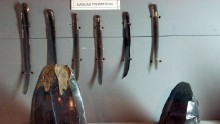

Today, although the technology and instruments that surgeons rely on are developing rapidly, electrosurgical knives, ultrasonic knives, gamma knives, and various energy platforms are widely used in surgery, but almost all operations still start with the use of this ancient tool. The direction of development of scalpel and surgical practice. In the early days, surgeons served as barbers constantly improved knives in practice, and the standard of sterilization was completely changed. The advanced civilizations of Greece and Rome created specialized surgical knives. Prehistoric humans occasionally used stone tools for medical activities. Is obsidian stronger than steel Since obsidian will fracture down to a single atom, it is claimed to have a cutting edge five hundred times sharper than the sharpest steel blade, and under a high magnification microscope an obsidian blade still appears smooth, whereas a steel blade has a saw like edge.

The scalpel has become a representative of surgery since the ancient Romans used it in the medical field. Obsidian on the left, stainless steel on the right Various styles of stainless steel scalpelsīut what is interesting is that although modern science and technology are developing very rapidly, obsidian knives in the Neolithic era observed under an electron microscope are actually sharper than steel knives. The latest technological development is the use of zirconium dinitride, diamond, polymer coatings, etc. To the naked eye the scalpel cut seemed smooth, but to the body’s healing process it might as well have been the Grand Canyon. The cut edges were jagged, uneven, irregular and messy. The steel scalpel cut at the microscopic level was pure mayhem. The electroplating process of nickel and chromium is used less and less on scalpels. The Obsidian cut was smooth, even and even. The retractable knife invented by Albucasis in the 10th century has also been accepted again as a safer device. Thanks to the high content of chromium in stainless steel, the stainless steel handle has strong corrosion resistance and can be used repeatedly. Saving Earth Britannica Presents Earth’s To-Do List for the 21st Century.With the development of modern technology, 316L, 440C and other stainless steel hard alloys have replaced carbon steel.
#Obsidian scalpel vs steel microscope update#
Britannica Beyond We’ve created a new place where questions are at the center of learning. The Obsidian Blade is a tool and melee weapon which was added in update V.0.1 to Green Hell.100 Women Britannica celebrates the centennial of the Nineteenth Amendment, highlighting suffragists and history-making politicians.
#Obsidian scalpel vs steel microscope how to#
COVID-19 Portal While this global health crisis continues to evolve, it can be useful to look to past pandemics to better understand how to respond today.Student Portal Britannica is the ultimate student resource for key school subjects like history, government, literature, and more.This Time in History In these videos, find out what happened this month (or any month!) in history.Damascus steel, in particular, is essentially a saw on a micro level, just that the 'teeth' are pretty much invisible to the naked eye.

Metal, on the other hand, is worked and folded upon itself numerous times, depending on how it is processed.


 0 kommentar(er)
0 kommentar(er)
